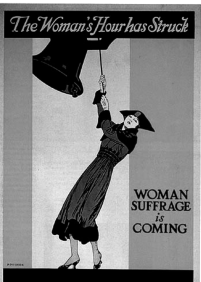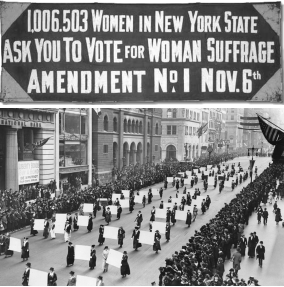|
Yates County and Women’s Suffrage
Yates Past - March/April 2009
 March is Women’s History Month and it is a good time to look at the struggle for women’s suffrage in Yates County and our state. New York State women did not have to wait for the ratification of the 19th Amendment to the U.S. Constitution in 1919. An amendment to the New York State constitution extended the vote to women two years earlier. In 1917, New York became the first eastern state to grant full voting rights to women, the twelfth state overall. However, that didn’t happen without a struggle. March is Women’s History Month and it is a good time to look at the struggle for women’s suffrage in Yates County and our state. New York State women did not have to wait for the ratification of the 19th Amendment to the U.S. Constitution in 1919. An amendment to the New York State constitution extended the vote to women two years earlier. In 1917, New York became the first eastern state to grant full voting rights to women, the twelfth state overall. However, that didn’t happen without a struggle.
It was natural that Yates County would play an active role in that struggle. In 1855, just eight years after the first women’s rights convention in nearby Seneca Falls, a similar convention was held on Main Street in Penn Yan. The main speaker at that convention was Susan B. Anthony of Rochester, who clearly stated that full voting rights for women was a primary goal of their movement. The issue slowly picked up momentum during the next half a century. It was the Progressive movement of the early 1900s that intensified the energy of those pushing for women suffrage in the county and the state. New Yorker Theodore Roosevelt had full voting rights for women on the party platform for his failed third party bid in the 1912 presidential election. That election resulted in another progressive, Woodrow Wilson, taking over the presidency and suffragists around the country were further encouraged. Wilson, however, had other priorities so the women’s movement intensified their efforts.
In the summer of 1913, it was announced that the question of women’s suffrage would be put before the (male) voters of New York as a referendum in November of 1915. In Penn Yan a group was organized in August of 1913 called the Political Equality Club. A similar group was formed in Dundee. They both became part of the statewide suffrage movement with a focus on the November 1915 referendum. Local suffragette leaders included Mrs. Charles Day, Mrs. Wendell Bush, Mrs. F. G. Merson, Ada Chapman, Eva Wise, Elizabeth Cramer, Ursala Swarts, and Louise Sheppard. For two years, these groups held parlor meetings in private homes, rallies in churches, outdoor rallies, and automobile parades. They distributed literature and brought in the best speakers from the statewide organization. They took their cause to every village, hamlet, and four corners in the county. At a street rally in Penn Yan on Memorial Day 1915, the Yates County Chronicle reported “Great interest was shown by the crowds that stopped to hear. Especially was this so when one old veteran declared that if women were given the vote, they should shoulder the musket and go to war. He was answered with much warmth by a comrade, who said his mother and sister had done all the work on a hundred and fifty acre farm while he was at war and that he considered their share of the work harder than his own.” As the 1915 referendum approached, the women gained important male allies. In September of that year, the Yates County Men’s League for Women Suffrage was formed with members from every town in the county. Their organization was comprised of public officials, clergymen, and business leaders. They held their own rallies to sway the male vote.
When the votes were counted in November, the women’s suffrage referendum went down to a crushing defeat statewide. In Yates County, 2,687 men voted NO and only 1,396 voted YES. The turnout was considered quite low as many men were indifferent to the issue. However, the spirit of the suffrage movement was not crushed. If anything, the leaders of the organization became more determined. The leader of the local movement, Mrs. Frankie G. Merson of Keuka Park, wrote in a letter to the Editor of the Chronicle “the women of our county have found themselves and will enjoy a fuller fellowship in future efforts than would have been possible before this campaign.” The statewide organization held its convention in Albany a year later. The state chair, a Mrs. Vira Whitehouse, told the convention “We failed because we worked like amateurs; we worked for suffrage when our work did not interfere with pleasures, or when our duty to suffrage did not interfere with other duties.” Another speaker said “No more pink teas, no more parlor meetings and abstract lectures for the suffrage cause. We are in the home stretch and we no longer need debates and historical summaries. We are a political organization and we are going to give straight votes-for-women appeals from this time on.” With that, they focused on getting the referendum on the ballot again in 1917, but determined to work harder for a different result. The white, elbow-length gloves were off.
In preparation for the 1917 campaign, the groups in Yates County that favored women suffrage combined into the Yates County branch of the New York State Women’s Suffrage Party. The head of the county organization was Florence Upson of Dundee and Mrs. Frankie Merson, a professor at Keuka College, was an organizer and liason to the statewide group. Once again, they took the movement to every corner of Yates County; holding rallies, bringing in speakers, and getting women’s signatures on petitions that simply said “I, the undersigned, believe that the vote should be given to the women of New York State.” By the summer of 1917, there were over 3,600 signatures on those petitions. That was all part of a statewide campaign to enroll a million women in the movement.
Events in 1917 seemed to favor the extension of the vote to women. In April President Wilson asked Congress for a declaration of war against Germany and we joined England and France in the Great War In Europe. There was a lot of talk about making the world safe for democracy and protecting the rights of free peoples everywhere. As the country mobilized for war that summer, women were asked to fill in for the men in factories and out on the farm. Women were being asked to join the Red Cross, get involved in food conservation, join Liberty Loan drives and Women’s War Relief. Suffrage movements in England and Canada were on the brink of realizing their goal.
In late August, Yates County delegates took the 3,600 signatures on their petitions to the statewide conference in Saratoga where, combined with the other counties, there was a grand total of over a million women on record wanting the vote. Yates County was recognized at the conference for having over fifty percent of its women enrolled. According to Mrs. Merson, “The delegates came back to Yates County knowing more surely than ever that the glorious vision of a world democracy that is rising before every people, in our efforts also for a complete democracy in the United States, to quote the dying words of Susan B. Anthony “Failure is impossible”. That September, the local chapter set up a “rest tent” at the Yates County Fair in Penn Yan where they handed out lemonade, literature, buttons, and had notable speakers. They did the same at the Dundee Fair in October. One speaker pointed out that eight million women in nineteen states already were able to vote in presidential elections.
| |
 |
| |
Suffrage Parade in New York City
October 1917 |
| |
|
In late October, just one week before Election Day, Yates County’s petitions for women’s suffrage were pasted onto five placards and were taken by local delegates to New York City for a massive parade of suffragettes down Fifth Avenue. Women carried the petitions on placards with well over a million signatures on them. It turned out to be the last parade for women’s suffrage in New York. With the support of the Governor behind the resolution, as well as the majority of the legislature, passage of the referendum on the ballot was considered a certainty. The county’s petitions were brought back to Penn Yan and placed in the window of Lynch Brothers Department Store for the few days before the election. As the Editor of the Yates County Chronicle stated in endorsing passage of the referendum, “The women understand they are struggling against deep-rooted prejudice in so conservative a state as New York, but they look forward to victory”. Mrs. Merson, in a letter to the newspaper, wrote “Ninety-five percent of the voters of Yates County will believe in women suffrage before the war is over. We only ask you to think ahead now, before November 6th. Time, effort, prayers have gone into this campaign. There are scores of women in Yates County who have given all their leisure for patriotic and suffrage work.”
On Election Day, the referendum on the ballot favoring full voting rights for women passed statewide by a wide margin and the women of New York did not have to wait for the federal constitutional amendment to be ratified after the war. However, in Yates County the referendum was overwhelmingly defeated. The Chronicle reported “The vote for women’s suffrage in Yates County at last week’s election resulted in 1.425 votes for the amendment and 2,242 against. In 1915, the vote stood 1,396 for and 2,687 against the proposition. In no district in the county in 1915 or 1917 did the women receive a majority of he votes. The town of Italy came the nearest, there being 49 votes for and 59 against the proposition this year”. It was the largest margin of defeat in any county in the state. Those who opposed suffrage had no organization and mounted no campaign.
Certainly disappointed over the local results, the members of the Yates County branch of the New York State Women’s Suffrage Party gathered at the Benham Hotel in Penn Yan that December to celebrate the statewide victory in a “Women’s Citizen’s Luncheon”. County leader Florence Upson was one of 800 leaders who attended the victory banquet at the Biltmore Hotel in New York City and gave a full report on that. They had lost the local battle against ignorance and apathy, but took great satisfaction in winning the ultimate goal; full voting rights.
Those five placards with the 3,600 signatures of women in the county who wanted to vote, were presented to the Yates County Historical Society in 1940 by Mrs. Alexander R. Thompson of Penn Yan, who was the Treasurer of the county branch of the state suffrage party. They have been a proud part of our collection and have been displayed several times over the years . In recognition of Women’s History Month, they will once again be on display in the Underwood Museum throughout the month of March. Is your grandmother or great grandmother on there? Come in and see.
by Rich MacAlpine
|
